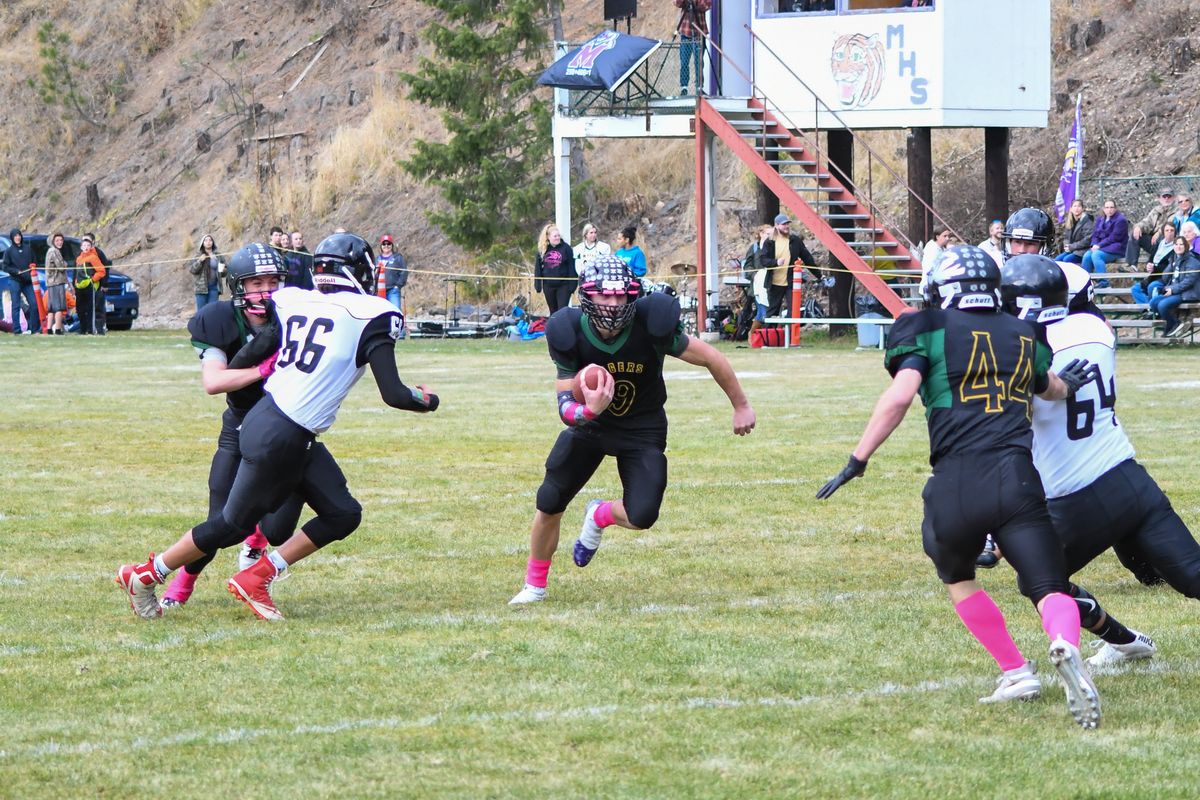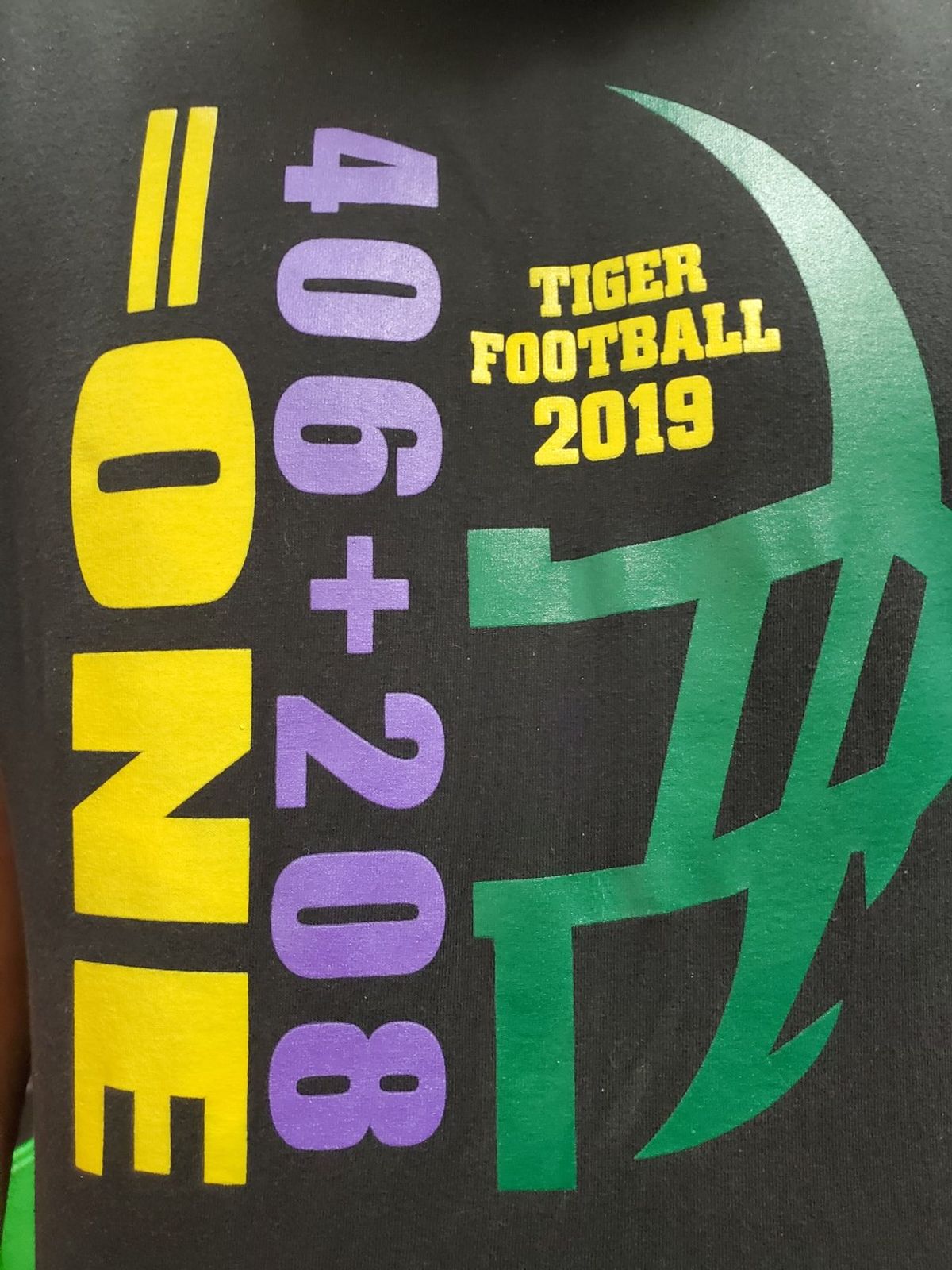Interstate co-op paying off big for Mullan, Idaho and St. Regis, Montana
Mullan-St. Regis running back Luke Trogden, middle, is a big reason the interstate co-op between the tiny Idaho and Montana schools is doing well. The Tigers (3-1) were ranked No. 3 in a recent Idaho 1A Division II football poll. (IdahoSportsPhotos.com)
Jesse Allan didn’t need a commercial drivers license to haul a half-dozen football players on a daily, 40-mile Interstate 90 commute with winding roads and a mountain pass that drops into rural North Idaho.
Allan, an assistant coach, teacher and athletic director in St. Regis, Montana, would begin loading up the tiny school’s activity van around 3 p.m. Mountain Time and get to Mullan, Idaho, at 3 p.m. Pacific Time for practice, beginning the daily grind of the 8-man football team’s rare interstate co-op.
They gain an hour up the hill, lose an hour down the hill before returning around 8 p.m. on practice days and usually 2 a.m. after away games.
Gaining bodies is more important at the two schools with respective enrollments of 31 and 35.
Allan has eight players from his side of the border, a CDL and a bus to drive to the historic Idaho mining town that houses a Mullan-St Regis team ranked No. 3 in the latest Idaho 1A Division II football poll.
Four years ago. the two programs were on life support before joining forces, one of two interstate co-ops in the region. Genesee, Idaho, and neighboring Colton, Washington, is the other, another 8-man football program (3-0) enjoying success in Idaho.
Three seasons into the co-op, Mullan-St. Regis (3-1) has a roster of 22 players, is a defending North Star League champion that averages 61 points a game.
Both teams forfeited games – sometimes seasons – before the merger due to meager numbers.
“It’s kind of a roller coaster at this level,” Mullan athletic director and head coach football Stetson Spooner said. “Sometimes you’re up, sometimes you’re down. We have a big freshman class in Mullan right now and will get another big class next year with our current eighth-graders.”
Talent helps.
Mullan, the last District I (North Idaho) tiny-school football team to win a state football title (1983-1984), was a tradition-rich program for decades up until around its 2006 state playoff berth.
Those teams often featured one or two stars and just enough depth to thrive in the wide-open, never-leave-the-field 8-man game, something Mullan had lacked in recent years.
The two-pronged attack of Mullan-St. Regis junior running backs and linebackers Luke Trogden – a Mullan student – and Adam Ball – a St. Regis student – has led to the Tigers’ resurgence.
Both 6-foot and 200 pounds, hard-hitting and with sprinter speed, Trogden and Ball combined for 16 touchdowns and more than 600 yards rushing in Mullan-St. Regis’s first three games.
Each has garnered recruiting interest from NAIA schools. A couple of Big Sky Conference coaches have also inquired about the two, according to Spooner and Ball’s father, St. Regis School principal Shawn Ball.
“Being able to compete against good teams and win has been fun,” Trogden said. “We have that depth now.”
Shawn Ball, whose sophomore son Caleb is the team’s quarterback, had a feeling success would come quick once the merger was approved.
“There’s some good athletes in both schools, but each didn’t have the team numbers on their own,” Ball said. “I don’t want to sound arrogant, but I’m really not surprised by how good the team is doing right now.”
Spooner, who pointed to the end of a yearslong mining strike at the Lucky Friday Mine to the uptick in Mullan student-athletes, agreed.
“It couldn’t have happened at a better time, talent-wise,” he said.
Tigers helping Tigers
When St. Regis – a team that hadn’t won a league title in roughly two decades – needed to combine with another school to keep a semblance of its football program alive, it couldn’t merge with other tiny neighboring Montana towns.
Down-the-freeway Superior and Alberton had already combined for a team. Hot Springs, about 40 miles north, would likely bump up a classification if it took on St. Regis’ players.
Mullan, which has long had the one of smallest high school student bodies in the Idaho panhandle, couldn’t combine with neighboring Wallace – a Silver Valley rival 8 miles away – for the same reason.
St. Regis approached Mullan about the prospect of a merger in 2018 and the Idaho High School Activities Association and Montana High School Association approved.
Neither school wanted to give up its decadeslong identity, but ultimately had no choice.
“There was some hesitancy at first with the communities,” Shawn Ball said. “But it was apparent we had to (merge).”
Fortunately for Mullan and St. Regis, neither had to concede its mascot.
Both schools are the Tigers but with contrasting school colors – Mullan’s purple and white and St. Regis’ green and yellow – they’re still honoring.
When Mullan-St. Regis plays its nonconference games in Montana, it wears St. Regis jerseys. In Idaho, it wears black and purple.
The schools celebrate two homecomings and senior nights on each side of the border, and adhere to different rules and field dimensions depending on where they play.
“The community support in St. Regis has been just as good if not better than ours,” Spooner said. “They’re in Montana, but have bought into Idaho high school football.”
Trogden, whose cousins Riley and Alex Trogden are also on the team, sees Mullan and St. Regis as essentially one school.
“They take all that time coming here to play, and we go out there, so we help each other,” said Trogden. “We’re friends, hang out in each other’s towns.”
Ball sees Mullan as “an extended family” from a parent and administrative perspective.
“We’ve blended as one,” Ball said. “The kids are very similar in nature, rough and rugged who love the outdoors.”
Will it stay this way?
St. Regis, a town of roughly 350 residents, has three major employers: a sizable, three-part convenience store, a mill and St. Regis School.
Thousands of Interstate 90 travelers stop into the St. Regis Travel Stop each week, getting gas, food, Montana-themed souvenirs and gifts, “The World’s Greatest Huckleberry Milkshake” and to check out a live trout aquarium.
There’s now pride in both its purple milkshake and purple Tiger football team looking to make a deep playoff run in November.
Mullan and St. Regis would like to combine in other sports, too, but traveling over a snowy pass most days in the winter and spring months would be too dangerous, administrators said.
Two years ago, Mullan’s boys basketball team played an entire season with five players and no substitute.
Mullan is carrying the weight of the football merger with 14 of the team’s 22 players and will likely have more next season.
In previous years, 14 players would be enough for Mullan to field a team. It won league titles in the early 2000s with similar numbers.
Conversely, St. Regis needs Mullan. With eight players – an increase compared to past years – it would have just enough to play 6-man football, which Montana offers.
“Ideally, we would love to have our teams in our own states,” Ball said. “But that doesn’t seem feasible right now.”

